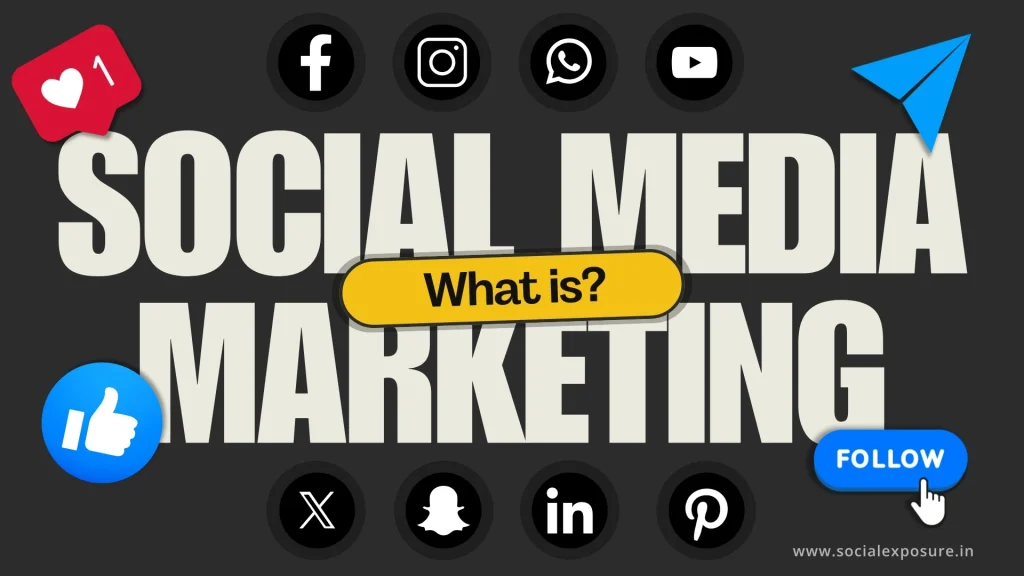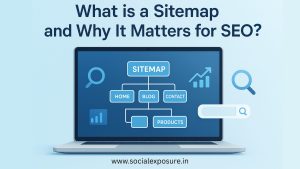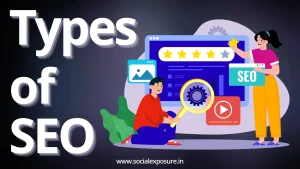Social media marketing (SMM) is a strategy used by businesses and individuals to promote brands, products, or services through social media platforms. It involves content creation, audience engagement, and paid advertising to reach and influence potential customers.
Popular platforms for social media marketing include Facebook, Instagram, LinkedIn, Twitter, TikTok, and YouTube.
Introduction
The way people connect, share, and consume information has changed significantly, and a big part of this shift is due to social media.
Every day, billions of users engage with platforms like Facebook, Instagram, Twitter, LinkedIn, and others, making these spaces more than just communication tools.
They have become powerful channels for brands, creators, and businesses to grow their reach, interact with audiences, and build credibility.
At its core, social media marketing is about using these platforms to promote products, services, or ideas.
Businesses, influencers, and marketers rely on social media not just for visibility but also for engagement, trust-building, and direct communication with their target audience.
Whether it’s a startup looking for its first customers or a well-known brand launching a new product, the right strategy can make all the difference.
This blog will break down social media marketing meaning, its purpose, and why it matters. It will also explore how businesses leverage it for growth, the essential components of an effective strategy, and how to measure success.
By the end, you will have a clear understanding of what is social media marketing and how it fits into modern business strategies.
What is Social Media Marketing?
Social Media Marketing Meaning and Definition
The internet has changed the way businesses reach and interact with their audience. Instead of relying on traditional advertisements or word-of-mouth marketing, companies now turn to social media marketing to create direct connections with consumers.
Social media marketing refers to the practice of using platforms like Facebook, Instagram, Twitter, LinkedIn, and others to promote products, services, or brands.
It involves creating content, engaging with audiences, running advertisements, and analyzing data to improve outreach efforts.
A simple way to understand social media marketing definition is that it is the use of social media to build relationships with customers, increase brand awareness, and drive sales.
Unlike traditional advertising, which often relies on one-way communication, social media allows for real-time conversations, making it a more interactive and engaging form of marketing.
How Social Media Marketing Works?
The Role of Social Media in Marketing
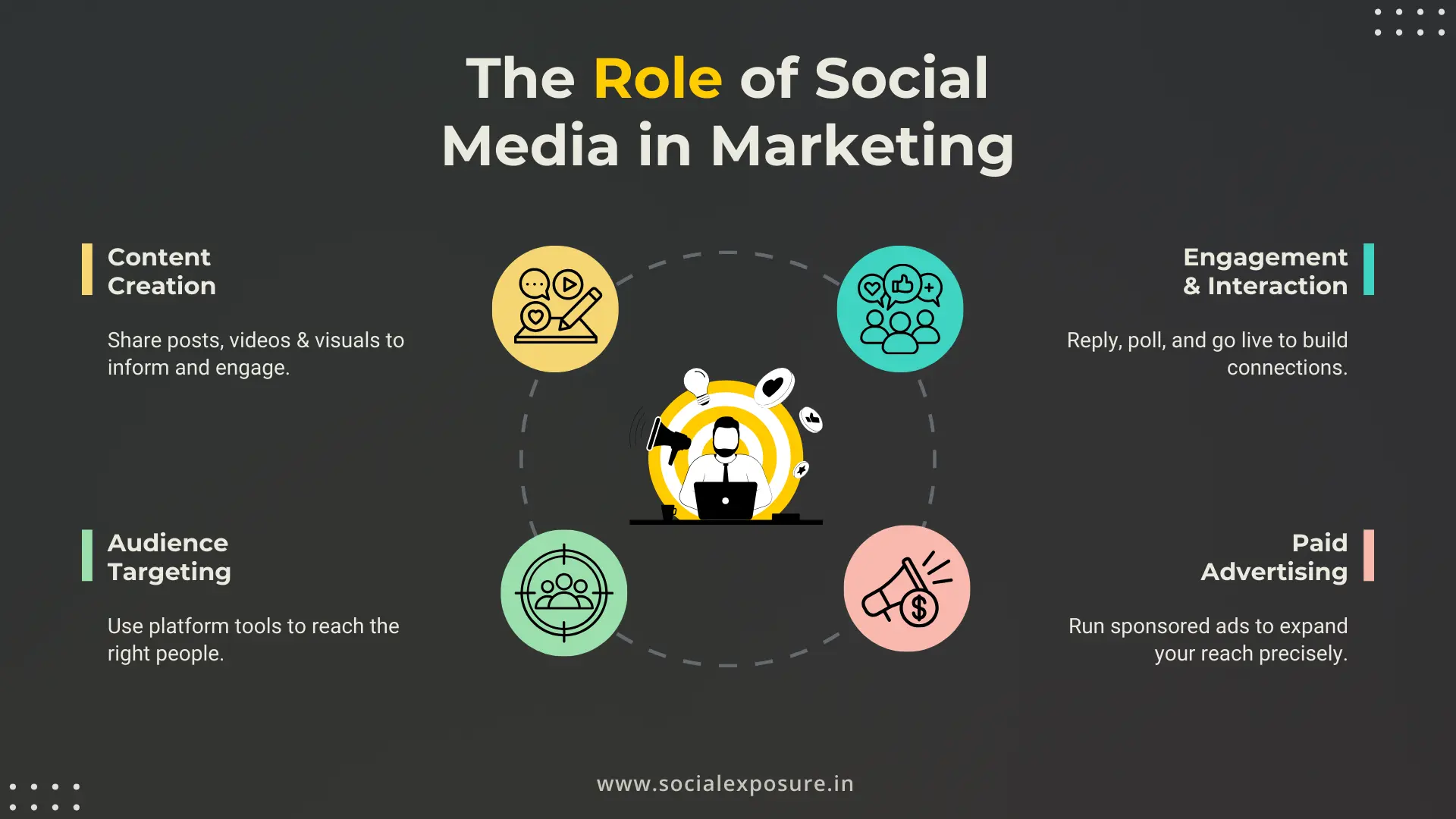
How does social media marketing work in real-world scenarios? Companies use different strategies depending on their audience and goals:
- Content Creation: Businesses share posts, videos, infographics, and other forms of content to keep their audience informed and engaged.
- Audience Targeting: Platforms provide advanced tools to target users based on interests, behaviors, and demographics.
- Engagement & Interaction: Replying to comments, running polls, and hosting live sessions help businesses create stronger relationships with customers.
- Paid Advertising: Brands use sponsored posts and paid ads to reach a wider audience with precision.
The effectiveness of social media marketing depends on consistency, relevance, and audience understanding. A well-executed strategy ensures that businesses remain visible, competitive, and connected with their audience.
Purpose of Social Media Marketing

The purpose of social media marketing goes beyond posting content. It’s about creating value for the audience while meeting business objectives.
Companies and creators invest in social media marketing to build relationships, strengthen brand identity, and drive meaningful engagement.
- Increasing Brand Awareness: Regularly appearing on feeds helps businesses stay recognizable and relevant.
- Boosting Engagement: Real-time interactions allow brands to respond quickly to customer inquiries, feedback, and concerns.
- Driving Conversions: Whether through organic engagement or paid campaigns, a well-structured social media marketing explained strategy can lead to higher sales and leads.
By integrating social media into their marketing plan, businesses gain a cost-effective way to reach their audience, promote services, and maintain long-term customer relationships.
When done strategically, it’s one of the most powerful tools for business growth today.
Importance of Social Media Marketing for Businesses
A strong social media presence is no longer optional for businesses, it is essential. The way people discover brands, engage with content, and make purchasing decisions has changed significantly.
With billions of users active on platforms like Facebook, Instagram, LinkedIn, and Twitter, businesses that do not prioritize social media marketing risk missing out on valuable opportunities.
Key Features of Social Media Marketing
A well-structured social media marketing strategy requires more than just posting content. Success depends on using the right approach for each platform, creating engaging content, and analyzing performance to optimize future efforts.
The features of social media marketing determine how businesses connect with audiences and achieve their goals.
How Different Platforms Function Uniquely?
Not all social media platforms work the same way. Each has its strengths and is best suited for different types of content and audience engagement:
- Facebook: Best for community building, paid advertising, and customer service interactions.
- Instagram: Focuses on visual content, storytelling through Stories and Reels, and influencer marketing.
- LinkedIn: Ideal for B2B networking, professional content, and industry discussions.
- Twitter: Works well for real-time updates, conversations, and brand engagement.
- TikTok & YouTube: Video-driven platforms that help brands connect with younger audiences through creative storytelling.
A strong social media marketing strategy recognizes these differences and tailors content accordingly.
Content Scheduling and Analytics in SMM
Consistent posting is essential for maintaining engagement. Many brands use scheduling tools to plan their content in advance, ensuring they reach audiences at optimal times. Meanwhile, analytics tools track performance, offering insights on:
- Which posts generate the most engagement.
- The best times to publish content.
- Audience growth and interaction trends.
By leveraging these features of social media marketing, businesses can continuously improve their approach and maximize their impact.
Popular Social Media Platforms Across the Globe
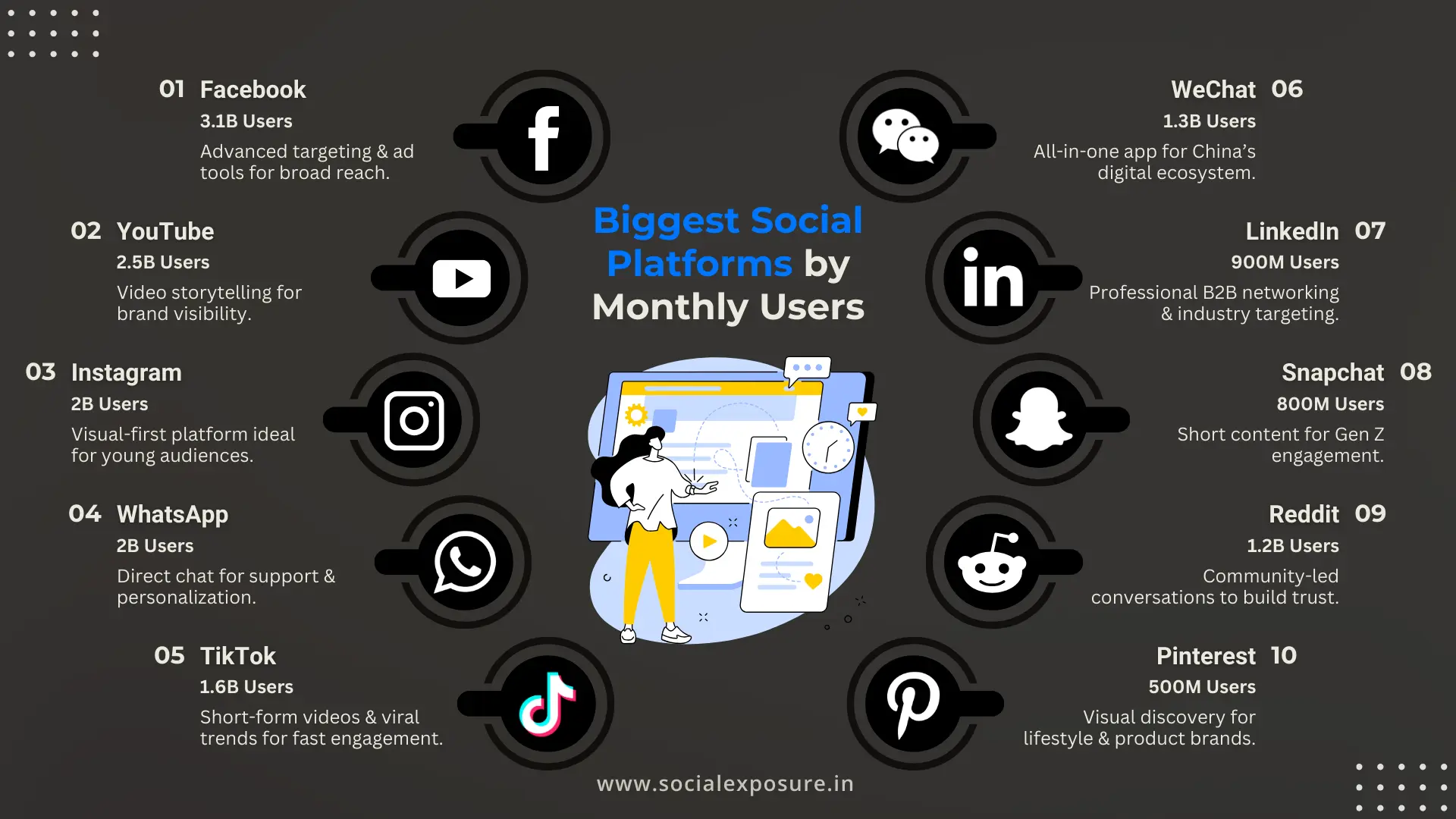
Social media platforms have become essential tools for businesses to connect with their audiences. Each platform offers unique features catering to different marketing strategies.
Here is an overview of major platforms and their global reach; for a detailed ranking, refer to global social networks ranked by number of users.
- Audience Size: Approximately 3.1 billion monthly active users as of 2024.
- Marketing Approach: Offers detailed audience targeting and advertising options, allowing businesses to reach specific demographics effectively.
- YouTube
- Audience Size: Around 2.5 billion monthly active users.
- Marketing Approach: Focuses on video marketing and brand storytelling, enabling brands to create engaging visual content.
- Audience Size: Approximately 2 billion monthly active users.
- Marketing Approach: Emphasizes visual content and influencer collaborations, making it ideal for brands targeting younger demographics.
- Audience Size: Around 2 billion monthly active users.
- Marketing Approach: Utilized for direct communication and customer support, fostering personalized interactions.
- TikTok
- Audience Size: Approximately 1.6 billion monthly active users.
- Marketing Approach: Leverages short-form video content and viral trends to engage users, offering brands a platform for creative campaigns.
- Audience Size: About 1.3 billion monthly active users.
- Marketing Approach: Combines messaging, social media, and payment services, providing a multifaceted platform for businesses, especially in China.
- Audience Size: Over 900 million members.
- Marketing Approach: Specializes in B2B marketing and professional networking, allowing brands to connect with industry professionals.
- Snapchat
- Audience Size: Approximately 800 million monthly active users.
- Marketing Approach: Engages younger audiences through ephemeral content and interactive features.
- Audience Size: Around 1.2 billion monthly active users.
- Marketing Approach: Facilitates community-driven discussions, enabling brands to build authority by participating in relevant conversations.
- Audience Size: Approximately 500 million monthly active users.
- Marketing Approach: Focuses on visual discovery and product marketing, ideal for brands in fashion, home decor, and lifestyle sectors.
Data and Facts
- Global Reach: As of January 2025, there are 5.24 billion social media users worldwide, equating to 63.9% of the total global population.
- User Engagement: The average person uses 6.83 different social networks per month.
- Advertising Spend: Social media advertising spend is projected to reach $276.7 billion in 2025, with 83% of that ad spend total generated on mobile by 2030.
Understanding these platforms and their unique features can help businesses tailor their social media marketing strategies effectively, ensuring they reach and engage their target audiences.
Social Media Advertising vs. Organic Marketing
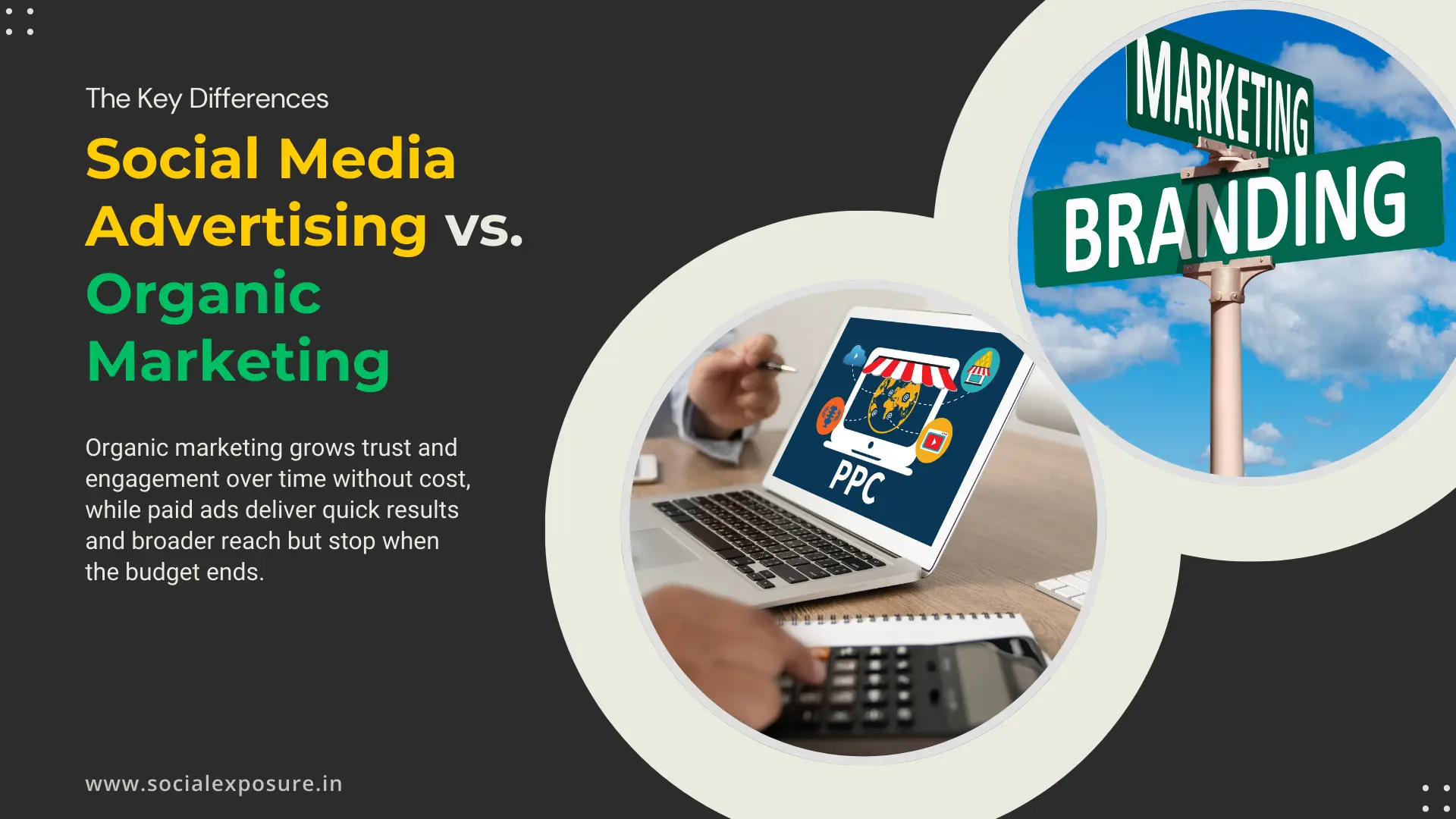
Difference Between Paid Ads and Organic Social Media Growth
Organic marketing involves growing an audience naturally through regular posting, engagement, and community building. It does not require direct payments but takes time to see results.
In contrast, social media advertising allows businesses to pay for visibility, reaching their target audience instantly through sponsored posts, display ads, and promoted content.
| Feature | Organic Marketing | Social Media Advertising |
|---|---|---|
| Cost | Free, but requires effort and consistency | Requires a budget for ad spend |
| Reach | Limited to existing followers and network | Wider reach, including new and specific audiences |
| Speed | Slow, requires patience | Immediate results |
| Engagement | Built through interactions, trust, and long-term relationships | Focuses on quick conversions and brand exposure |
| Sustainability | Long-lasting, continues to bring results over time | Stops when the budget runs out |
Pros and Cons of Social Media Advertising vs. Organic Marketing
Both organic marketing and social media advertising offer unique advantages and challenges.
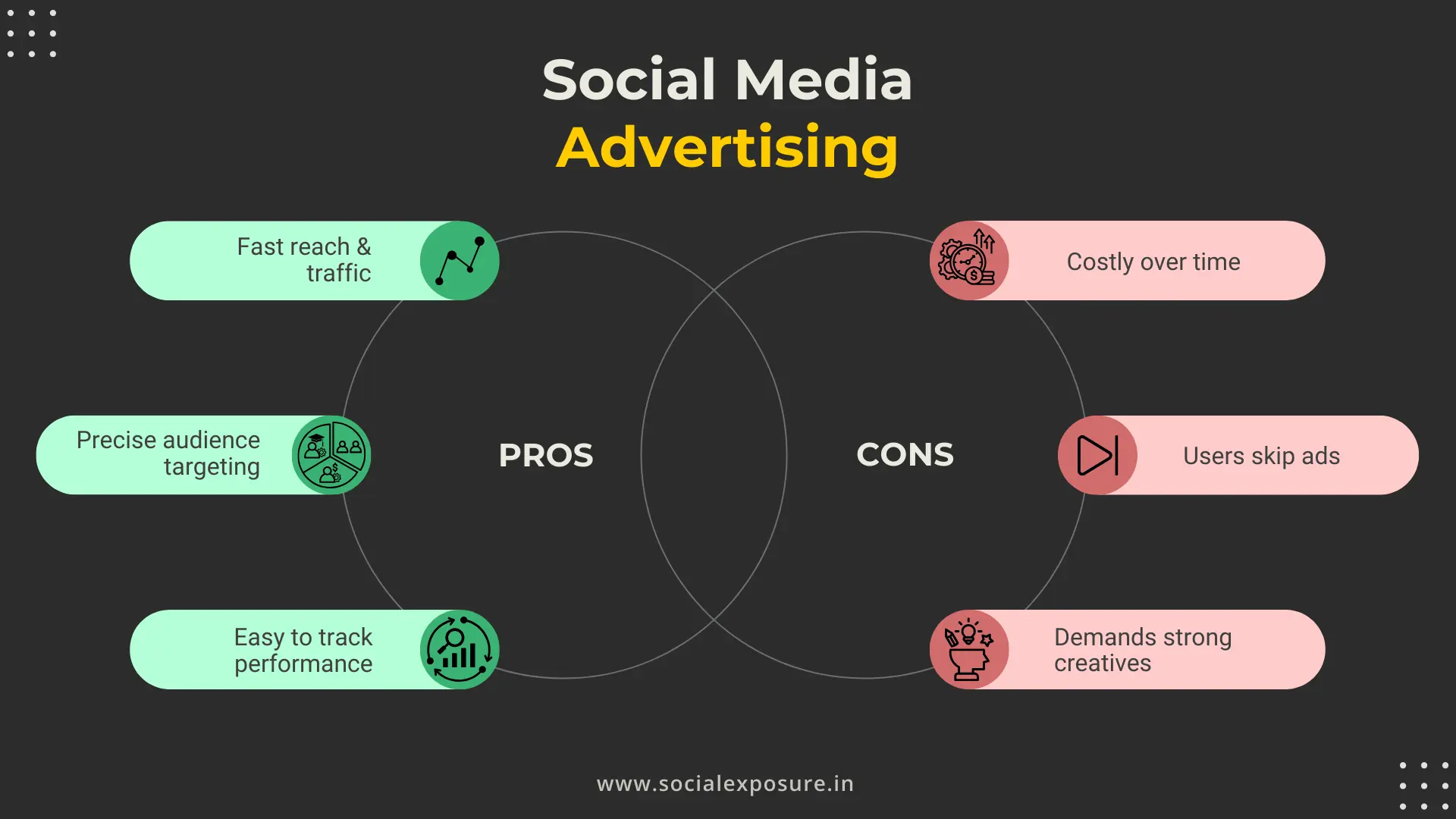
Pros of Social Media Advertising
- Delivers instant visibility and traffic.
- Provides detailed audience targeting options.
- Offers measurable performance insights.
Cons of Social Media Advertising
- Requires ongoing investment to maintain results.
- Ads can be ignored or skipped by users.
- Needs strong ad copy and visuals to perform well.
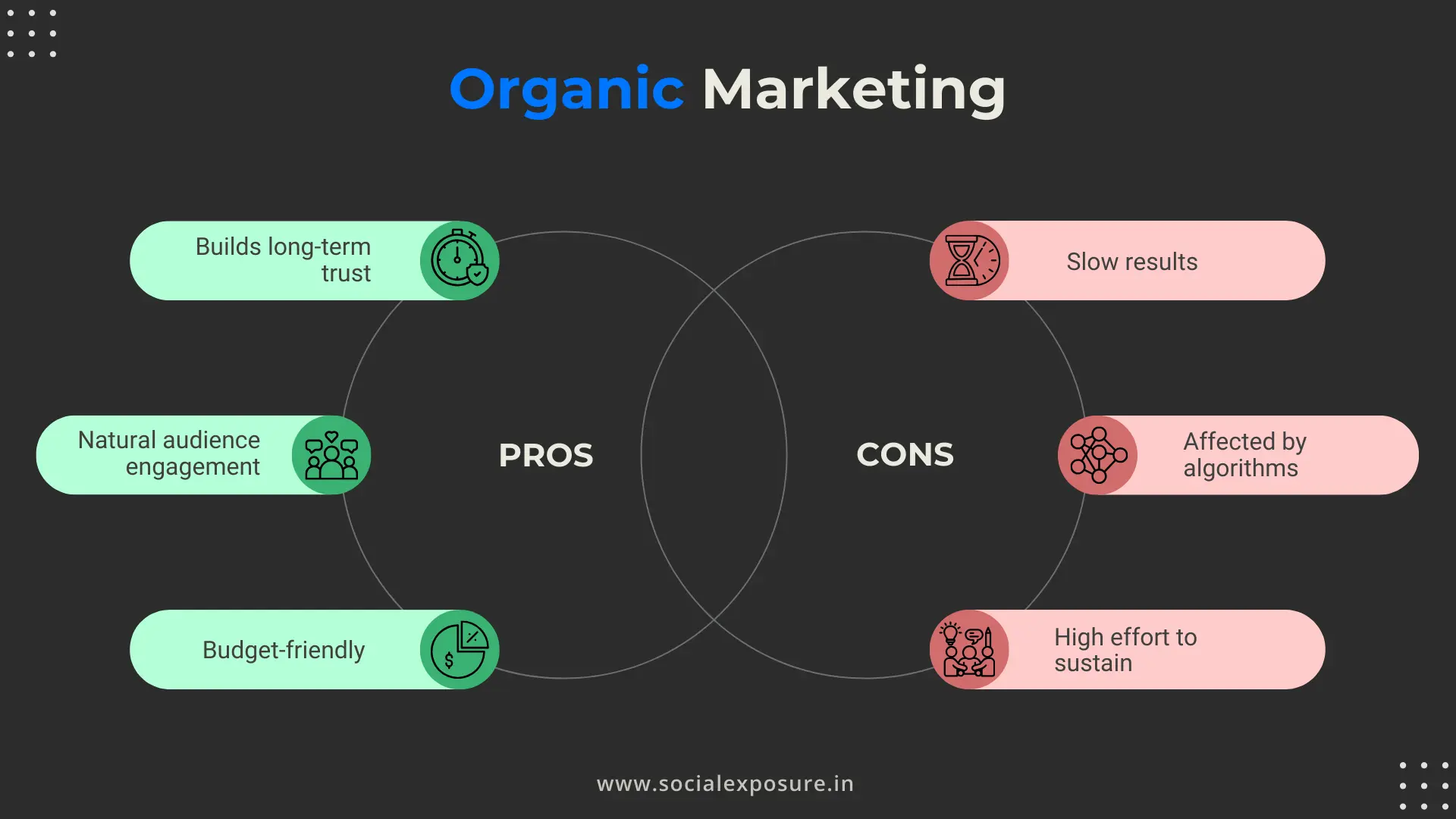
Pros of Organic Marketing
- Builds long-term brand loyalty.
- Encourages natural engagement and trust.
- Cost-effective for small businesses.
Cons of Organic Marketing
- Takes time to see significant results.
- Algorithm changes can reduce visibility.
- Requires continuous effort to maintain engagement.
A balanced social media marketing strategy often combines both approaches. Brands build trust and community through organic marketing while using social media advertising to boost visibility and drive immediate results.
What is a Social Media Campaign?
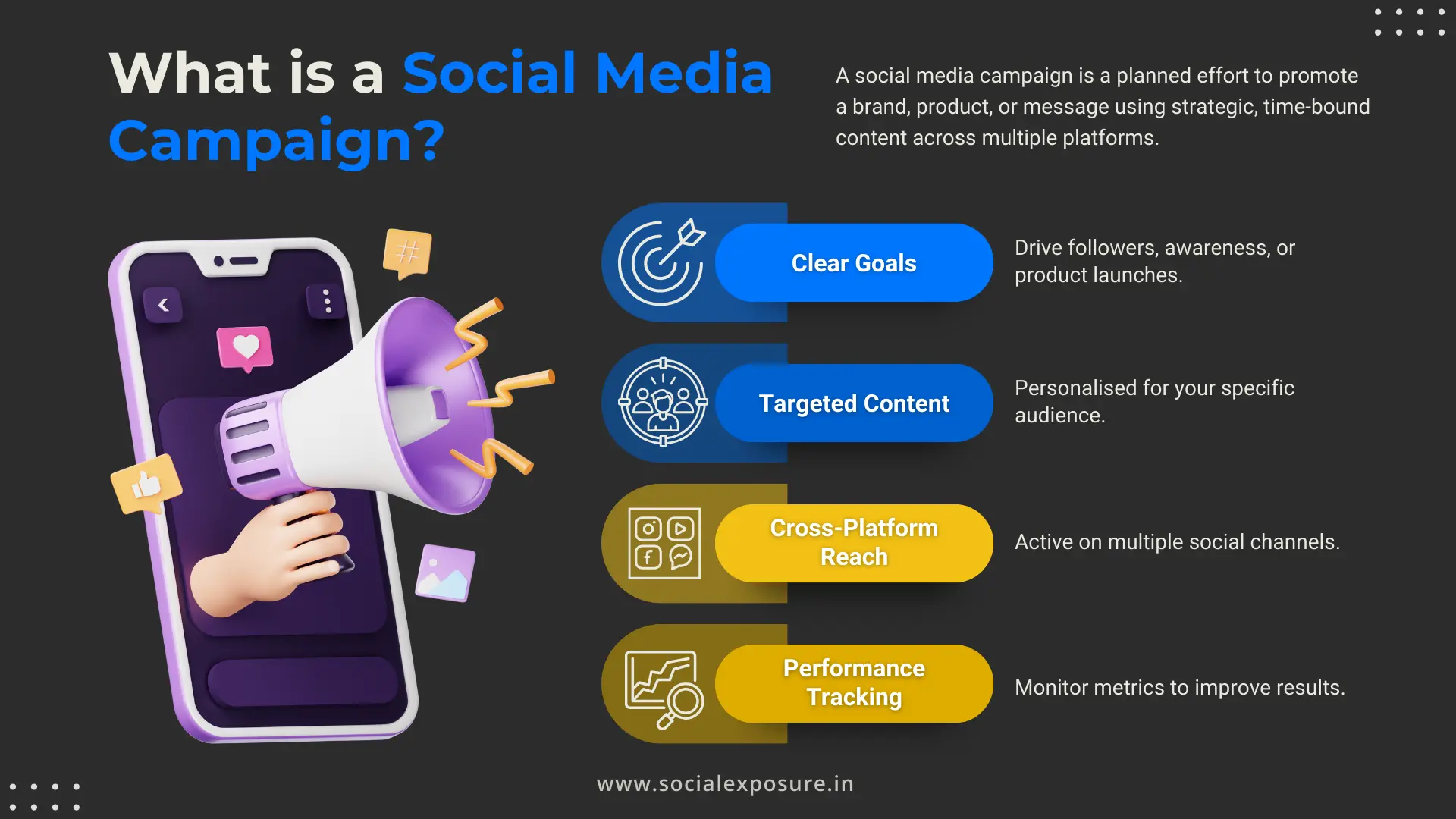
A social media campaign is a coordinated effort to promote a brand, product, or message across social media platforms. Unlike everyday posts, these campaigns are strategic, goal-oriented, and often run for a specific period.
Businesses use them to increase brand awareness, drive engagement, generate leads, or boost sales.
A well-executed social media campaign involves:
- Clear objectives: Whether it’s increasing followers, launching a new product, or raising awareness, each campaign has a defined goal.
- Targeted content: Content is customized to resonate with the intended audience.
- Cross-platform strategy: Campaigns often span multiple social media marketing platforms to maximize reach.
- Performance tracking: Analytics help brands measure success and optimize their approach.
This approach ensures that brands engage their audience effectively while achieving measurable results.
Examples of Successful Social Media Campaign
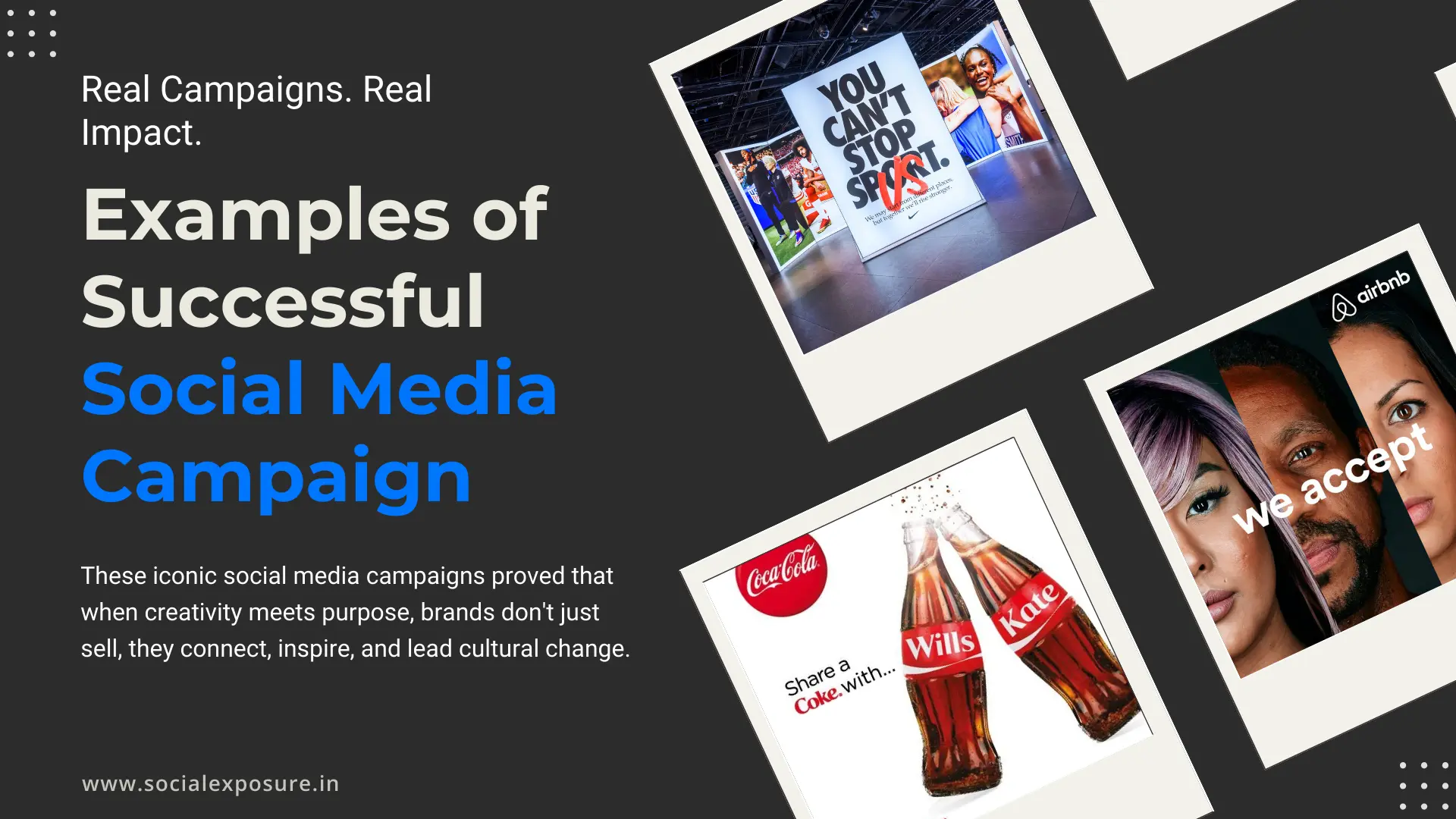
Some of the most impactful campaigns have driven massive engagement and brand loyalty. Here are a few examples:
- Nike’s “You Can’t Stop Us” Campaign
Nike’s campaign focused on resilience, diversity, and unity, using a split-screen video featuring athletes from different backgrounds. The campaign generated millions of views and strengthened brand loyalty. - Coca-Cola’s “Share a Coke” Campaign
By personalizing bottles with common names, Coca-Cola’s “Share a Coke” campaign encouraged users to share pictures with their customized bottles, leading to viral engagement.. - Airbnb’s #WeAccept Campaign
Launched during the Super Bowl, Airbnb campaign promoted inclusivity and diversity, generating widespread social media discussions and brand support.
Each of these campaigns highlights how social media marketing explained strategies can turn simple ideas into movements that resonate with audiences.
By focusing on creativity, authenticity, and audience connection, businesses can design impactful campaigns that leave a lasting impression.
The Role of Content, Influencers, and Trends
For businesses, staying relevant means keeping up with social media trends, creating engaging content, and leveraging influencer collaborations.
- Content Marketing: Blogs, videos, and social posts that provide value help brands establish credibility and authority.
- Influencer Collaborations: Partnering with influencers boosts visibility and connects brands with niche audiences.
- Trending Topics & Challenges: Brands that engage with viral trends see higher engagement and brand awareness.
By understanding the role of social media in marketing, businesses can design strategies that not only attract attention but also drive real engagement and conversions.
Common Challenges in Social Media Marketing
Businesses today face increasing pressure to maintain a strong online presence, but social media marketing challenges often make this difficult.
While platforms offer opportunities to engage audiences and grow brand awareness, they also come with obstacles that require strategic solutions.
Difficulty in Audience Engagement and Competition
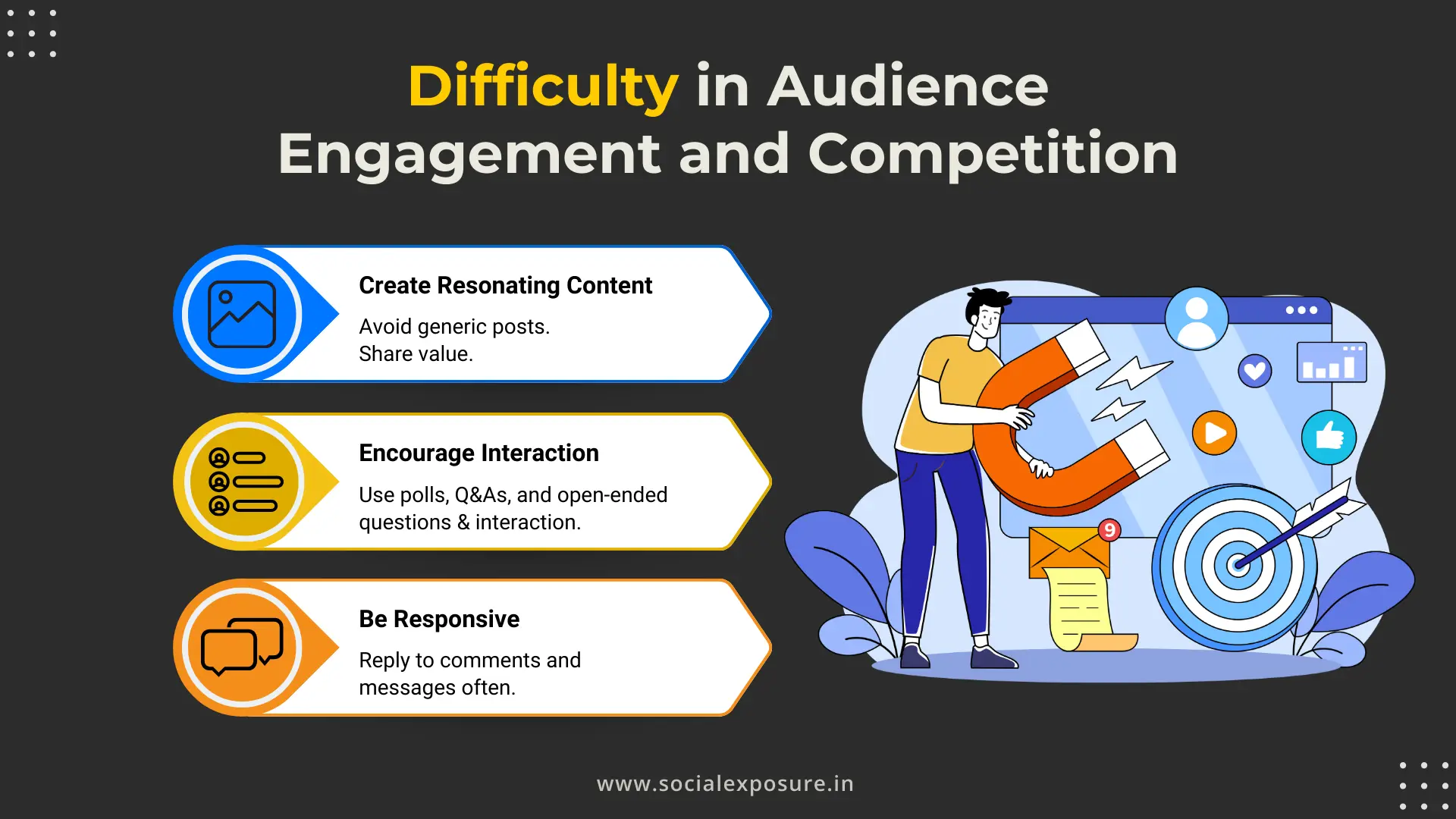
With millions of businesses using social media, standing out is not easy. Competition is high, and users are constantly bombarded with content. This makes audience engagement a challenge, as brands must:
- Create content that resonates: Generic posts fail to grab attention. Unique and valuable content is necessary to maintain engagement.
- Encourage interaction: Posts that include polls, Q&A sessions, and discussions perform better.
- Respond actively: Ignoring comments and messages reduces audience trust. Brands must engage consistently.
For businesses wondering how social media marketing works, the key is not just posting frequently but building meaningful connections with their audience.
Algorithm Changes Affecting Organic Reach
Social media algorithms prioritize content that keeps users engaged. This means that organic posts from brands often struggle to get visibility unless they generate high engagement. Challenges include:
- Declining organic reach: Platforms like Facebook and Instagram favor paid content, making it harder for brands to gain visibility without advertising.
- Changing algorithm rules: What works today may not work tomorrow, forcing brands to constantly adjust their strategies.
- Reliance on ads: Many brands shift to paid promotions to maintain reach, increasing marketing expenses.
To overcome these social media marketing challenges, businesses must stay updated on platform changes and optimize content for engagement.
Managing Consistent Content Creation and Strategy
Consistency is essential for success in social media marketing, but maintaining a regular posting schedule can be overwhelming. Brands often struggle with:
- Time and resource constraints: Creating high-quality content takes effort, and smaller businesses may lack the resources.
- Content fatigue: Posting repetitive or uninspired content leads to declining engagement.
- Strategy execution: A lack of planning often results in inconsistent messaging.
Overcoming these challenges requires a combination of strategy, adaptability, and engagement. Businesses that stay informed and focus on building relationships rather than just posting will see better long-term success.
Conclusion
The way businesses and creators connect with their audience has changed, and social media marketing is at the center of this transformation.
From increasing brand awareness to driving engagement and conversions, the importance of social media marketing cannot be overstated.
Whether through organic strategies or social media advertising, businesses that leverage these platforms effectively stay ahead of the competition.
For brands looking to grow, consistency and strategy matter. Engaging content, audience interaction, and data-driven insights are key to long-term success.
Partnering with a Social Media Marketing Agency like Social Exposure can help businesses craft customized campaigns, optimize engagement, and achieve measurable results.
Now is the time to take action. Whether you’re a small business owner, influencer, or entrepreneur, implementing these strategies can help build a strong presence and drive growth.
Frequently Asked Questions
What is Social Media Marketing and why is it important?
Social media marketing is the practice of using platforms like Facebook, Instagram, LinkedIn, and Twitter to promote products, services, or brands. It helps businesses connect with their target audience, increase brand awareness, and drive engagement.
The importance of social media marketing lies in its ability to provide cost-effective marketing solutions, real-time engagement, and measurable results for businesses of all sizes.
How does social media marketing work for small businesses?
For small businesses, social media marketing offers a low-cost way to build brand visibility and attract customers. By sharing valuable content, engaging with followers, and running targeted ads, small businesses can compete with larger brands.
Using tools like content scheduling, audience insights, and ad campaigns, they can grow their presence without requiring a massive budget.
What are the main benefits of social media marketing?
Some of the biggest benefits include:
- Increased brand awareness: Businesses can reach millions of users worldwide.
- Direct customer interaction: Real-time engagement through comments, messages, and live sessions.
- Cost-effective marketing: Compared to traditional advertising, social media advertising offers a more affordable way to promote products.
- Data-driven insights: Analytics tools help track performance and optimize marketing strategies.
What is the difference between social media marketing and social media advertising?
The key difference is that social media marketing includes all organic and paid efforts to promote a brand, whereas social media advertising specifically refers to paid campaigns, such as sponsored posts, display ads, and video ads.
While marketing focuses on content creation, engagement, and community building, advertising uses targeted ads to reach specific audiences quickly.
Which social media platform is best for marketing?
The best platform depends on the target audience and business goals:
- Facebook: Best for paid ads and customer engagement.
- Instagram: Ideal for visual content and influencer collaborations.
- LinkedIn: Perfect for B2B marketing and professional networking.
- TikTok & YouTube: Effective for video marketing and brand storytelling.
How do businesses measure the success of a social media campaign?
Businesses track the success of their social media campaigns using:
- Engagement rates (likes, shares, comments).
- Click-through rates (CTR) on posts and ads.
- Conversion rates (purchases, sign-ups).
- Follower growth and reach.
- Return on investment (ROI) from paid ads and organic marketing efforts.
How can someone start a career in social media marketing?
Starting a career in social media marketing requires learning key skills like content creation, data analysis, and audience engagement. Newcomers can begin by:
- Taking online courses or certifications in social media marketing.
- Gaining hands-on experience by managing personal or business accounts.
- Learning about social media advertising and analytics tools.
- Staying updated with platform algorithm changes and industry trends.
What are the most common mistakes businesses make in social media marketing?
- Inconsistent posting: Irregular updates can reduce engagement.
- Ignoring audience engagement: Failing to respond to comments and messages weakens brand trust.
- Overusing promotions: Constantly pushing sales without adding value can turn followers away.
- Not analyzing data: Without tracking performance, businesses cannot improve their strategy.
Does social media marketing work for all industries?
Yes, but the approach varies. While e-commerce and entertainment brands see fast engagement, industries like finance, healthcare, and B2B require more trust-building efforts. Every industry can benefit from a customized social media marketing strategy tailored to its audience.
How often should businesses post on social media?
The ideal posting frequency depends on the platform:
- Facebook & Instagram: 3–5 times per week.
- Twitter: Multiple times daily.
- LinkedIn: 2–3 times per week.
- TikTok & YouTube: At least once a week for video content.
Consistent posting ensures steady engagement, but quality matters more than quantity. Businesses should focus on delivering valuable content that resonates with their audience.

